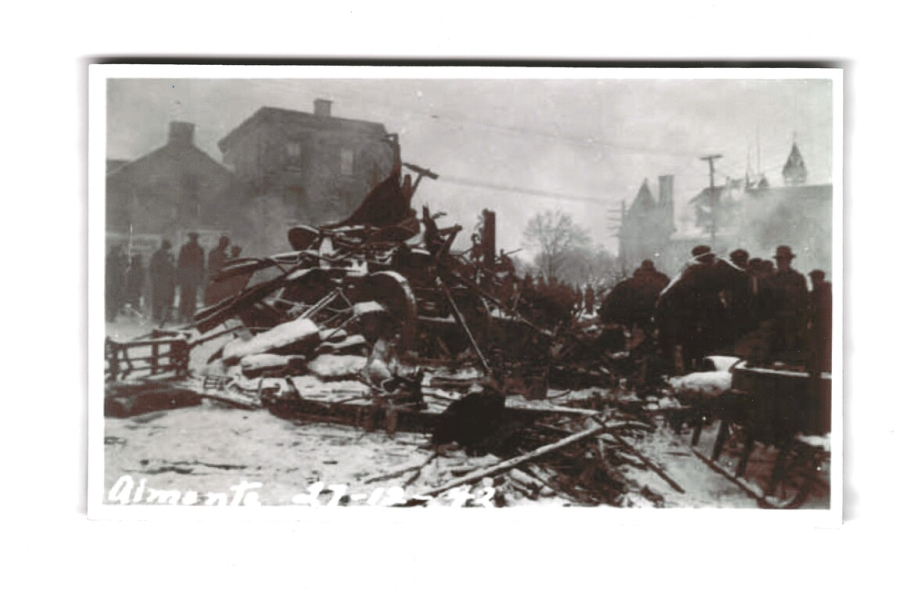William Peacock stood with dozens of people on the platform of the Almonte train station. December 27, 1942 was a miserable night with snow and freezing rain falling as the Almonte police chief joined others to see family and friends off who needed to work the next morning. It was 8:32 p.m. when the Local train pulled into the station. Six minutes later, it was about to leave.
The Local had started its journey in Petawawa three hours earlier. Extra crew and more coaches had been added because of the heavy load of passengers. It was a milk run with stops throughout the Ottawa Valley, but the passengers were singing Christmas songs, trying to make the best of a dreary holiday season that included restrictions on Christmas lights and food rations.
At the back of the train, five-year old Bernie Turcotte peeked out the back window and then turned to his mother and said, “Mommy what is that bright light?” Seconds later, at 8:38 p.m., a heavy troop train slammed into the back of the Local passenger train, obliterating the final two coaches of the train and coming to rest half-way through the third last coach.
Earlier in the evening, a 20-minute block had been initiated at the Renfrew and Arnprior stations, but with no operator working at Pakenham, the troop train continued to make up ground on the lead train. When it came around the gradual bend leading into the Almonte station, there wasn’t enough time for the engineer to stop. He was only a few car lengths away from the stopped Local train when he saw the reflection of his train’s headlights on the glass windows at the rear of the Local.
The impact was sudden and devastating. Within 24 hours, 36 people had died and more than 150 people had been hospitalized, some with life-altering injuries. Two more passengers on the Local train would pass away within a few weeks bringing the death toll to 38, making the Almonte train wreck one of the deadliest railway accidents in Canadian history.
In the weeks that followed, a coroner’s inquest held at the Almonte Town Hall, the same building used on the night of the accident as a temporary morgue, would exonerate the crews of both trains of any wrongdoing. The five-man jury blamed the Canadian Pacific Railway, primarily because the company had not staffed the Pakenham station, arguing that had an operator been on duty, the troop train could have been held back to give the Local train time to clear the Almonte station.
But Canada’s Transport Commission had a different opinion on what caused the deadly crash. The commission cited three violations of the operating rules and blamed the crews of both trains for the accident. The commission felt the troop train was travelling too fast and the engineer did not have his train under control when he arrived in Almonte. The commission also said the crew on the Local train had erred by not lighting a flare at the back of their train when they knew they were running behind on their schedule.
It's been more than 80 years since the Almonte train wreck occurred. There are few survivors of the accident still living, but there are many family members who still hold the stories of that fateful night. For them, the tragedy lives on through photographs, letters, and newspaper clippings. The family of Thomas Lynn, a survivor of the crash, keeps the train ticket he used to board the Local. Lynn badly injured his leg in the crash, preventing him from joining the Canadian military. Not being able to serve his country bothered him for the rest of his life, and when he passed away in his 73 rd year, his family found his ticket from December 27, 1942 in his wallet. He had kept it for more than 50 years, but no one in his family knew he had it.
In Almonte, the train station was torn down years ago, the railway tracks have been removed and in the centre of the town there are two large engraved stones that memorialize the victims of the crash. Sudden Impact – The Almonte Train Wreck of 1942 was written to ensure they are remembered.
Biography:
 Jamie Bramburger, author, Sudden Impact – The Almonte Train Wreck of 1942Jamie Bramburger was trained as a broadcast journalist and spent 14 years working as a news director, assignment editor and news reporter in radio and television, before joining Algonquin College’s Pembroke Campus as its Manager of Community and Student Affairs. That was 25 years ago, but while working at the college, Jamie has retained his journalistic roots as a volunteer broadcaster with Cogeco community television and as a feature writer with Post Media. Sudden Impact -The Almonte Train Wreck of 1942 is Jamie’s second book. His first book, Go Kings Go-A Century of Pembroke Lumber Kings Hockey was released in 2018 and became a regional best seller in Eastern Ontario.
Jamie Bramburger, author, Sudden Impact – The Almonte Train Wreck of 1942Jamie Bramburger was trained as a broadcast journalist and spent 14 years working as a news director, assignment editor and news reporter in radio and television, before joining Algonquin College’s Pembroke Campus as its Manager of Community and Student Affairs. That was 25 years ago, but while working at the college, Jamie has retained his journalistic roots as a volunteer broadcaster with Cogeco community television and as a feature writer with Post Media. Sudden Impact -The Almonte Train Wreck of 1942 is Jamie’s second book. His first book, Go Kings Go-A Century of Pembroke Lumber Kings Hockey was released in 2018 and became a regional best seller in Eastern Ontario.







